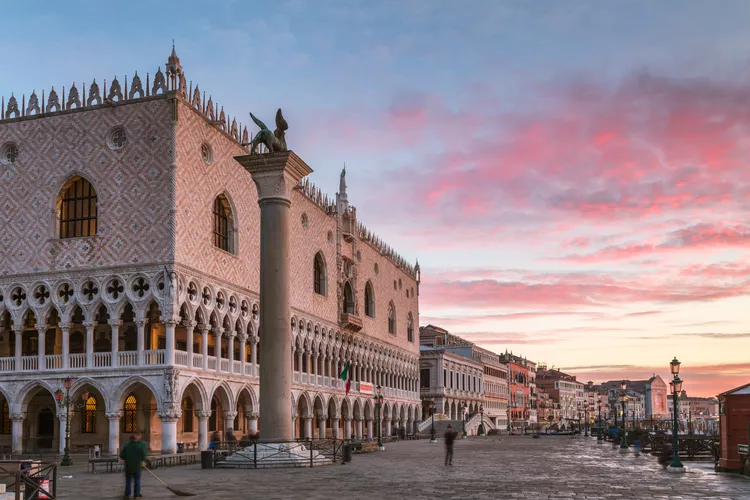Exploring Doge’s Palace in Venice
History of Doge’s Palace
Doge’s Palace, also known as the Palazzo Ducale, is one of the most significant historical landmarks in Venice. Located on the grand Piazza San Marco, this palace served as the residence of the Doge (ruler of Venice) and functioned as the center of power for the Venetian Republic for over 1,000 years. It is now a prominent museum that attracts countless visitors each year.
Architectural Wonders
The Doge’s Palace is renowned for its lavish Gothic architecture and intricate interior design. The stunningly detailed exterior features a grand open portico, patterned brickwork, and a notable second-floor balcony. Inside, grand staircases, gilded ceilings, and beautifully frescoed walls create a breathtaking atmosphere. The palace also housed the prisons of the Republic, accessed via the iconic Bridge of Sighs, a site that adds a layer of intrigue to its historic significance.
Key Attractions Within the Palace
Arcade Statues by Filippo Calendario
The chief architect of the Doge’s Palace, Filippo Calendario, not only crafted the open arcade defining the ground floor but also designed several captivating sculptures, including “Noah’s Drunkenness.” These sculptures can be seen on the south façade and allegorical roundels that showcase Venetia across the arcades facing the Piazzetta.
Porta della Carta
Constructed in 1438, the “Paper Gate” is a crucial entrance linking the Doge’s Palace to the Basilica of San Marco. Designed by architect Bartolomeo Buon, this gate is adorned with remarkable Gothic-style characteristics such as spires, trefoils, and a majestic winged lion—a symbol of Venice. There are differing theories on the gate’s name, which might relate to either state archives or the submission of written requests to the government.
Foscari Arch
Located just beyond the Porta della Carta, the Foscari Arch showcases beautiful Gothic spires and statues. It features stunning sculptures of Adam and Eve crafted by the renowned artist Antonio Rizzo, who also designed the impressive Renaissance-style courtyard of the palace.
Scala dei Giganti
This magnificent grand staircase leads visitors to the main floor of the Doge’s Palace. It is aptly named as it is flanked by imposing statues of the gods Mars and Neptune, amplifying its grandeur.
Scala d’Oro
The “golden staircase” features a stunning stucco ceiling adorned with gold. Construction commenced in 1530 and reached completion in 1559. The Scala d’Oro serves as a splendid entrance for dignitaries visiting the stately rooms on the upper floors of the Doge’s Palace.
The Museo dell’Opera
The Museum of the Doge’s Palace, which connects to the Scala d’Oro, showcases an array of original architectural elements from the palace’s 14th-century arcade, providing wonderful insights into its rich history.
The Prisons
Known as I Pozzi (the wells), the dark prison cells within the Doge’s Palace are located on the ground floor. In the late 16th century, as the need for more prison facilities grew, the Venetian government constructed the Prigioni Nuove (New Prisons). The notorious Bridge of Sighs functions as a pathway between the palace and the prison, accessible from the Sala del Maggior Consiglio on the second floor.
The Doge’s Apartments
The Doge’s former residence occupies nearly a dozen rooms on the second floor, featuring richly decorated ceilings and fireplaces. This area also showcases the Doge’s Palace picture collection, which includes striking representations of the iconic lion of St. Mark as well as masterpieces by Titian and Giovanni Bellini.
The Sala del Maggior Consiglio
As the grand assembly room for the Great Council, which was composed of all noblemen aged 25 or older, this hall was completely consumed by flames in 1577. However, it was restored with remarkable detail between 1578 and 1594, featuring a stunning gilded ceiling that illustrates the historical triumphs of the Venetian Republic alongside portraits of past Doges and frescoes by masters such as Tintoretto and Veronese.
The Sala dello Scrutinio
This second-largest chamber on the palace’s second floor served dual purposes as a vote-counting room and a gathering spot for meetings. It shares the lavish decorations found in the Sala del Maggior Consiglio, with a beautifully carved ceiling and monumental paintings depicting Venetian maritime battles adorning the walls.
The Sala del Collegio
The Venetian Republic’s cabinet convened in this third-floor space, which features the Doge’s throne, an elaborately painted ceiling by Veronese, and walls showcasing celebrated artworks by Tintoretto. English art critic John Ruskin famously stated that this room provided visitors with a profound insight into the essence of Venice.
The Sala del Senato
This impressive chamber was where the Senate of the Republic of Venice gathered. The ceiling is adorned with stunning works by Tintoretto, while two large clocks on the walls helped Senators keep track of time during speeches.
The Sala del Consiglio dei Dieci
The Council of Ten, a covert service established in 1310 following a conspiracy against the government led by Doge Falier, met in this discreet room. The Council focused on monitoring other branches of governance, including reviewing incoming and outgoing communications. The ceiling is beautifully decorated by Veronese, while Tiepolo’s large painting, “Neptune Bestowing Gifts upon Venice,” serves as a highlight of this space.





